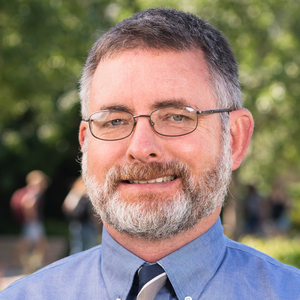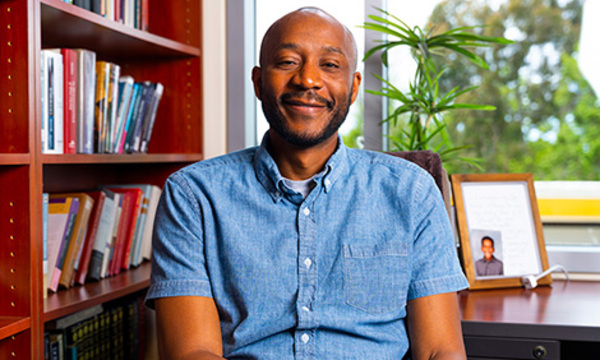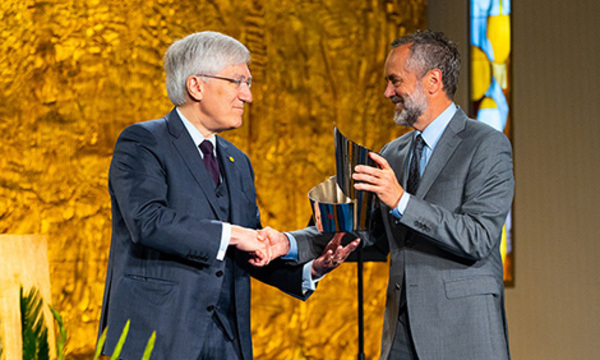With giant steps, the founders of Biola walked out of the age of the Civil War, strode across the continent and laid deep foundations in a new city at the edge of the world.
They were very deliberate in choosing an urban setting on the Pacific Rim. The Panama Canal was about to connect the Atlantic Ocean to the Pacific (1904-1914), and a giant aqueduct (1908-1913) was about to supply the new city with water. Crowds would be coming, and those crowds would need the gospel. Biola’s founders worried that the churches in Los Angeles were not prepared to meet the spiritual needs of the explosive urban growth. They wrote, “The Church needs Sunday School teachers, helpers, evangelists, and leaders who know the Bible …” and it was in order to train those leaders that the Bible Institute of Los Angeles was founded.
Three of the founders stand out from the crowd of workers involved. Oil millionaire Lyman Stewart had a history of Christian philanthropy all over the Los Angeles area.
He promoted religious education at local colleges, started the Union Rescue Mission and helped numerous churches with their financial needs.
Lyman and his brother Milton also financed the publication of The Fundamentals, a 90-chapter series of books that put the best conservative scholarship into the hands of a wide audience. The money for The Fundamentals was given anonymously, crediting “two concerned laymen” who saw churches losing their grip on the fundamentals of the faith. The Stewarts were worried and had money; they combined an intelligent concern with a keen sense of strategic opportunities for the church.
T. C. Horton was a pastor with a special talent for inspiring and organizing small groups. The emphasis of his ministry can be summed up in the titles of his two published books, Personal and Practical Christian Work and The Wonderful Names of Our Wonderful Lord. Everywhere he went, he built teams of grassroots workers, which would thrive and expand. His wife, Anna — universally known as “Mother Horton” by early students of the Institute — was equally successful in a host of women’s ministries, including an especially dedicated group known as “The Bible Women.” When the Bible Institute opened its doors in 1908, there was a ready-made constituency to be found in the hundreds of young people already involved in groups led by the Hortons.
Stewart and Horton had already put together an effective Bible institute, but they were eager to establish the school’s national and international reputation. To do that, they needed to hire a star faculty member. What they felt they really needed was a world-famous evangelist who was also qualified to oversee an educational project. Since Dwight Moody was dead and Billy Graham hadn’t been born yet, the ideal person was R. A. Torrey, who had earned two degrees at Yale, had worked with Dwight L. Moody, and had taken the gospel around the world on a celebrated revival tour.
Torrey agreed to come to Los Angeles if they could build a church big enough to hold him, and so the nondenominational Church of the Open Door was founded. Torrey was given total control of the Institute’s academic decisions, from curriculum to faculty hiring, and doctrine classes used his book What the Bible Teaches. Torrey led the way in making the Institute a welcome place for conservative Protestants of all denominations. (“I’m an Episcopresbygationalaptist,” Torrey joked about his own affiliation.)
The Bible Institute of Los Angeles was always intended to be at the heart of the city. In fact, when the first building was planned for the intersection of Sixth and Hope, some team members were disappointed that it was so far out from the urban core. By mid-century, of course, 558 South Hope Street was considered downtown, and there was no room to expand as enrollment increased.
Biola would eventually relocate its entire operation to the quiet suburb of La Mirada. But the industry and population density around Los Angeles transformed the entire region into a megalopolis, and now La Mirada hardly seems like a distant, underdeveloped olive grove. As a result, Biola is still strategically located for modern ministry, in a Southern California more diverse, influential and expansive than the founders could have imagined.
At the ceremony for the laying of the cornerstone of the 13-story building downtown, Lyman Stewart pledged that the Institute in all its teaching would be “intolerant of error, but have a love for the souls of men as wide as the world. It will fellowship with, and bid Godspeed to all who love the truth as revealed in the Holy Scriptures.” He described the school’s position in these words: “For the teaching of the truths for which the Institute stands, its doors are to be open every day in the year, and all people, without reference to race, color, class, creed [denomination], or previous condition, will ever be welcome to its privileges.” These were visionary words at the beginning of the 20th century, and they continue to guide the school in this opening decade of the 21st.
In 1908 there were already plenty of colleges and seminaries, but the Bible Institute of Los Angeles was neither. It was designed to meet a need not met by any existing institutions. Its goal was to train laypeople in how to use the Bible and how to do practical, direct Christian evangelism. In one sense, Biola has obviously chosen to pursue a different institutional plan from that of the founders. In the course of the 20th century, the Bible Institute turned into a college, added graduate schools and is now a Christian university with a full spectrum of majors and disciplines.
But the outlines of the original mission are still evident in the work of this Christian university. The faculty in each of the disciplines strives to teach from a clearly Christian point of view. The 30 units of Bible instruction for every undergraduate continue the old Bible Institute ideal of an army of godly laypeople, qualified to enter the workforce and bear witness there with an informed, attractive Christian faith. And as we celebrate our centennial, Biola is finding creative new ways to honor our fathers and mothers in the faith by carrying forward the work they started into more fields than even our founders foresaw.
 Biola University
Biola University
.jpg)

